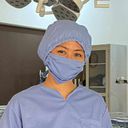Join the world's fastest growing Medical Learning Community!
Professional medical education in effective and innovative way.What can you do on MEDizzy?
Gain knowledge
Stay up to date
Discover Medical Cases
Ask questions
Help others
Discuss
What is MEDizzy?
MEDizzy is the world’s fastest growing medical learning community. Together with our network of partners we educate over 10 million now and future healthcare professionals.We provide an innovative technology designed to enable quick and easy access to the latest medical knowledge. We offer unique medical learning experience appreciated by HCPs from over 120 countries.
Browse Latest MCQ Questions
Browse through thousands of multiple-choice question quizzes and expand your knowledge! MCQs are a great way to prepare for your incoming exams!
CORAZON
El seno coronario drena en la aurícula izquierda.
CORAZON
La arteria coronaria izquierda irriga principalmente el ventrículo derecho.
CORAZON
¿Cuál de las siguientes ramas es una derivación de la arteria coronaria izquierda?
CORAZON
¿De qué parte del corazón nace la arteria coronaria derecha?
CORAZON
¿Cuál es la arteria principal que irriga al corazón?
Dermatology Test 2
All of the following are considered type II immune reactions, except:
Dermatology Test 2
A 6-month-old boy presents to the emergency department with fever and tachypnea, and is found to be in diabetic ketoacidosis. He has a history of intractable watery diarrhea and a gradually worsening eczematous dermatitis. His older brother had many of the same conditions, along with hypothyroidism, and died in early childhood. This likely represents a defect in _____, a key signaling molecule in _____
Dermatology Test 2
A patient presents with recurrent MRSA abscesses, thrush, and chronic lung infections. Laboratory examination reveals extremely elevated levels of IgE. Hyper IgE syndrome in DOCK8 deficiency can be distinguished from that occurring in STAT3 deficiency by:
Dermatology Test 2
A patient presents with recurrent MRSA abscesses, thrush, and chronic lung infections. Physical examination reveals facial dysmorphism and retained deciduous teeth. The most likely mutation is in_____.
Dermatology Test 2
CTLA-4 binds to ____, and serves to ____T-cell activation. _____binds to and inhibits CTLA-4.
Dermatology Test 2
Local skin necrosis following the use of soft-tissue filler for the correction of dermal rhytides occurs most frequently at which of the following sites?
Dermatology Test 2
Treatment with which of the following lasers most commonly results in purpura?
Dermatology Test 2
Which of the following lasers operates in the red portion of the electromagnetic spectrum?
Dermatology Test 2
Neutralization of which of the following chemical peels is important to prevent excess penetration?
Dermatology Test 2
What does Botox cleave?
Dermatology Test 2
What neurotransmitter is blocked by botulinum toxin?
Dermatology Test 2
Uniform white frost with pink showing through correlates with what depth of injury after a trichloroacetic acid peel?
Dermatology Test 2
Endovascular venous ablation techniques using laser or radio frequency can be most safely applied to which of the following veins?
Dermatology Test 2
Which of the following wavelengths penetrates most deeply into the skin?
Dermatology Test 2
Which of the following chemical peel agents is most likely to cause cardiac arrhythmias?
See more
Unique Learning Experience in your pocket!
We offer mobile learning platform where healthcare professionals share their knowledge, experience and useful learning resources with other peers in a quick and effective way.Our innovative and powerful mobile application is used by tens of thousands passionate medical learners every day.It provides not only instant access to the latest medical news and research but also enables quick communication with medical peers around the globe.
Assess your knowledge
With a powerful question bank MEDizzy helps better review, understand and retain medical knowledge gained during courses and everyday practice.Perfectly designed 30,000+ high yield medical multiple choice questions and flashcards from 21 major specialties are ready to easily check your knowledge.It’s a perfect assessment tool that helps you quickly find out the areas to be improved.
Browse Latest Discussions
Browse the latest discussions created by our users, and engage in meaningful conversations. Create, comment, share, and help build the best medical community in the world!
Browse discussions
Hetal Taviyad10 months ago
Want to study medicine? Need help with your studies?
Start right now! We can help you!


